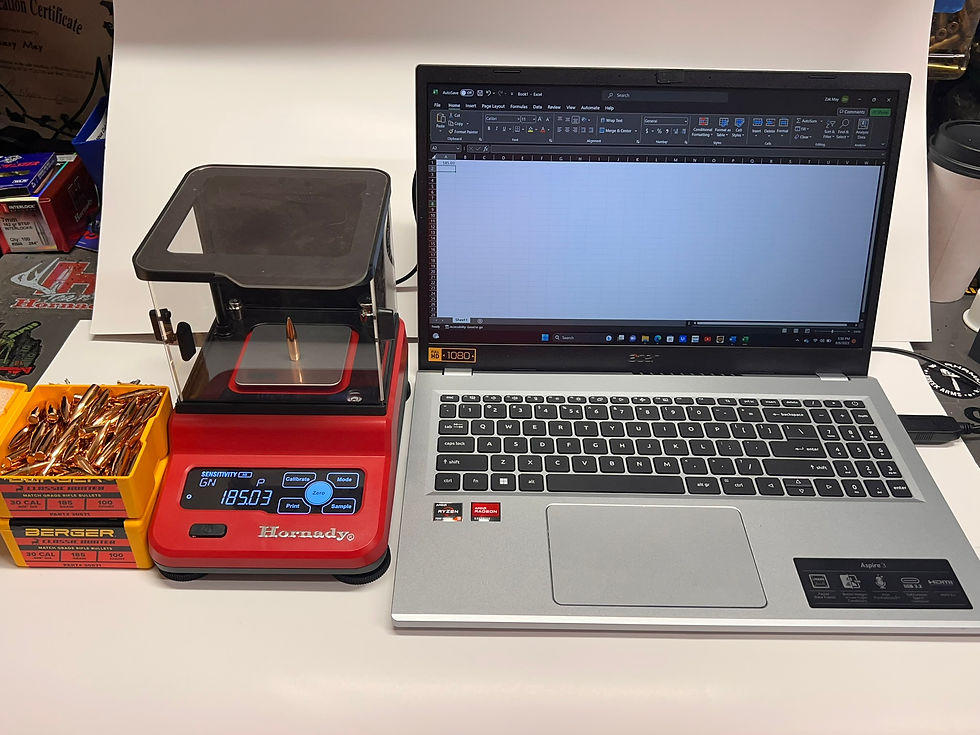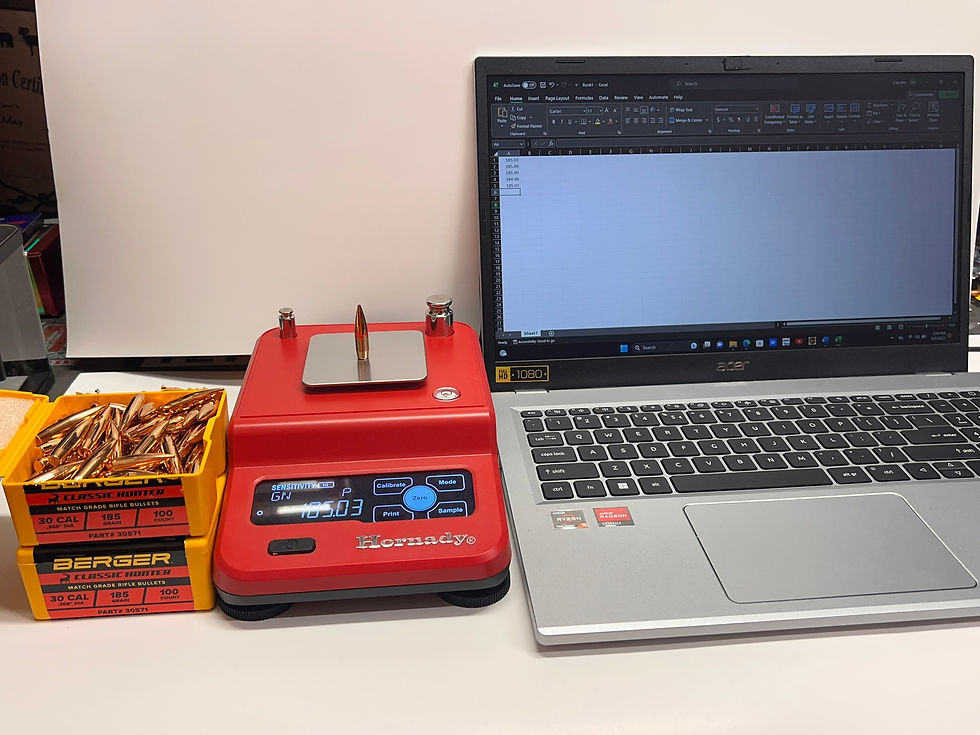Hornady Precision Lab Scale Testing and Review
- Zak May

- Oct 15, 2024
- 4 min read

Hornady announced this scale in late 2022. They were released in the spring of 2023. This scale fills in the market for the mid-level price range. This scale impressed me with the build quality and level of detail on precision. It offers a readout of 0.01-grain with the option to lower the sensitivity to 0.1-grain readout, which will run faster, but you lose a little of the precision. A lot of scales only read to 0.1-grain. The option to go to 0.01-grain allows for handloader to be incredibly precise in his weight measurments. High-quality load cell and cast aluminum base scale accuracy are +/- 0.04-Grains. This scale has three modes and weight options: Ounce, Grams, and Grains. Its weight limit is 3,000 grains, which should work well for most handloaders' needs. Like any electronic scale, you want to let it warm up for at least 15 minutes before calibrating. Scale is easy to calibrate with the two calibrated check weights, 10 and 50 grain. The scale has a bubble level and four leveling feet to ensure a stable platform for weighing powders and other components. To turn the scale on/off, you must push and hold the button, which is nice so it's not accidentally shut off. The rest of the controls are on a touch screen that responds well, and the screen is clear and easy to read. Readout numbers are just under 1/2 ", so they are nice and big to read.

The scale comes with a three-door removable windscreen, Powder pan, Wall Charger Power Cord, and an RS232 to USB cable to plug into a Computer. This unit is nice and compact, measuring 5 ¾" wide, 9" deep, and 6 ¾" tall with the windscreen on, so it will not take up much room on the bench! That's a huge bonus, as we all know hand loaders like to collect equipment, which takes up precious bench space.
The mode menu under the settings menu allows you to set the scale speed; speed settings allow for faster readouts when not needing to read out to .01 and change the units of measurements being used. The compare function allows you to set a nominal weight and a tolerance range and easily compare items to your acceptable range. Great for sorting brass, bullets, and other components. The percent function allows you to set a nominal weight and compare items to your acceptable weight in percentage form. The Piece function allows you to count the number of parts in the batch based on the weight of a small sample size.
Hornady did a good job with the outputting data function. The precision lab scale can output data into the spreadsheet program of choice, which is by far one of the scale's greatest features.
It’s very easy to set up this function and user-friendly; you plug the RS232 cable into the back of the scale and the USB side into a computer. Then, open a spreadsheet, place an item on the scale, and tap print. This will print out the value displayed on the screen and put it in the spreadsheet. A "P" will be displayed on the scale's screen once the print button is tapped; the “P” will be displayed until the object is removed and the scale returns to zero.

In my check weight testing with RCBS check weights, I obtained good accuracy and repeatability when running a test. With the scale on the sensitivity of high, in my testing, I saw a high variance of +.03 Grain in difference and a low of -.01. With a 0.5 Grain check weight, I got 0.5 Grain; with a 1.0 grain, I got 1.0 grain, 2.0 grains I got 1
a 1.99 grain, 4.0 Grains I got 4.01 gains, 5.0 grains I got 5.01 grain, 10.0 grains I got 10.03 grain, 20.0 grains I got 20.01 grains, and on 40.0 grain, I got dead on 40.0 grains. The RCBS Deluxe Scale Check Weight Set was used in this testing. It is ideal for the hand loader who wants to have the ability to check a scale across its entire range. This is particularly important for shooters who sort bullets or cases. These scales are accurate to what is stamped on them.
I also performed some other testing against another scale, but its accuracy is limited to 0.1 grain. This required a trip to the range to test Standard Deviation (SD), Extreme Spread (ES), and average velocity; I used Lapua 223 Remington brass with CCI Small Rifle NO. To test this, 400 primers, Varget powder, and Speer Target Match 52 grain BTHP. The scale that only reads to 0.1 grain got an average velocity of 3,091 FPS (Feet per Second), a standard deviation of 23 FPS, and an extreme spread of 63 FPS. Results with the Hornady Precision Lab Scale average velocity of 3,088 FPS, a standard deviation of 9 FPS, and an extreme spread of 27 FPS. The sample size results are small but show that when you add more precise instruments, the results get better.

The Compare mode was the most helpful and will be used a lot going forward. Allowing you to set a nominal weight and tolerance is a big-time saver for me when sorting bullets and brass. Also, the capability of sending data straight to a spreadsheet lets you not have to worry about paper and notepads all over that precious workspace on the bench.
All in all, this scale offers a lot to the advanced handloader who's seeking a precision loading scale at a modest price. It weighs powder charge weights to the .01 of a grain or sorting brass. It really can do all that you need as a handloader. Hornady got this design and function spot on.




I have a Hornady Scale. I hope this one is better. My last one had an issue with the power supply transformer making the weight change with the same item. Mine is older but i had to go back to the RCBS Beam scale.
Hornady hit it out of the park with this one. The new powder trickler that they have also works great. This new generation of hornady products is giving RCBS a run for their money.